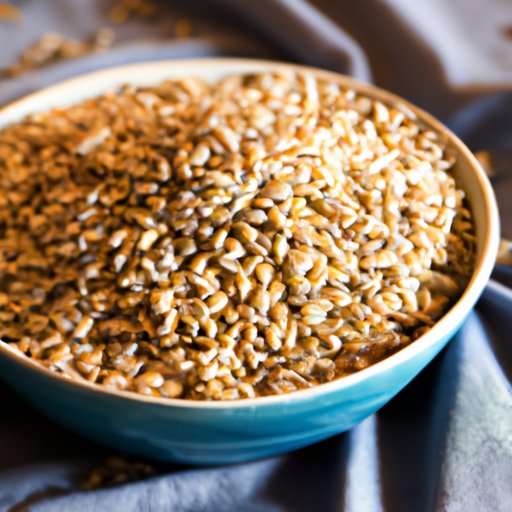Discovering the Versatility of Farro: A Complete Guide to Cooking, Recipes, and Benefits
Are you seeking to incorporate more whole grains into your diet? Farro, also known as emmer wheat, is a nutrient-dense ancient grain that has been making a resurgence in modern cuisine. In this article, we will explore the art of cooking farro, provide recipe ideas for different occasions, compare cooking methods, delve into its nutritional value, and demonstrate how it can be used as a substitute for other grains. Whether you’re a seasoned cook or a beginner, this comprehensive guide will help you master the art of cooking farro.
A Step-by-Step Guide to Preparing Farro
Before diving into the recipes, it’s essential to learn how to properly prepare farro. Unlike other grains, farro needs to be soaked before cooking to reduce its cooking time.
To soak farro, place it in a bowl of water and let it sit for at least an hour. Drain the water and transfer the farro to a pot with fresh water. Typically, the ratio of water to farro is 3:1. Bring the water to a boil and then reduce to low heat to simmer and cook for about 20-30 minutes until the farro is tender with a slightly chewy texture.
Once your farro is ready, you can season it with almost anything! Olive oil, lemon juice, cheese, and herbs are perfect compliments to the nutty flavor of farro. You can also mix in any cooked vegetables or meat to add even more depth of flavor and nutrition.
Farro-based Recipes for Different Occasions
Farro is an excellent source of protein and fiber, making it ideal for any meal of the day. Here are some of our favorite recipes featuring farro:
Hearty Farro Breakfast Bowl
- 1 cup of cooked farro
- 1 egg, poached or fried
- 1/2 avocado, sliced
- 1/2 cup of cooked kale or spinach
- 1/2 cup of cherry tomatoes
- Salt and pepper, to taste
Layer everything in a bowl and enjoy a nutritious breakfast that will keep you full for hours.
Farro Salad
- 1 cup of cooked farro
- 1/2 cup of cherry tomatoes, halved
- 1/4 cup of fresh parsley, chopped
- 1/4 cup of feta cheese, crumbled
- 2 tablespoons of olive oil
- 1 tablespoon of lemon juice
- Salt and pepper, to taste
Mix everything together in a bowl and enjoy a delicious, refreshing salad.
Chicken and Farro Soup
- 1 pound of boneless, skinless chicken breast
- 1 cup of cooked farro
- 2 celery stalks, chopped
- 2 carrots, chopped
- 1 onion, chopped
- 4 cups of chicken broth
- 2 cloves of garlic, minced
- 2 tablespoons of olive oil
- Salt and pepper, to taste
In a large pot, heat olive oil over medium heat. Add onions, garlic, celery, and carrots, and cook until onions are translucent. Add chicken broth and chicken breasts, bring to a boil, then reduce heat to low and let simmer for 30 minutes. Remove chicken breasts, shred, and return to pot. Add farro, salt, and pepper and let simmer for another 10 minutes.
Comparing Different Cooking Methods for Farro
Farro can be cooked with various methods beyond the stovetop:
Instant Pot Method
To use an Instant Pot, place one cup of farro with three cups of water or broth into your pot, and close the lid. Cook on high pressure for 10 minutes and let the pressure release naturally for 10 minutes. Drain and enjoy your perfectly cooked farro.
Rice Cooker Method
The rice cooker is another convenient way to cook farro. Place one cup of farro with 2 1/2 cups of water in the rice cooker and press the cook button. Allow the farro to “rest” for a bit after it finishes cooking, and then fluff with a fork.
Baking Method
To bake farro, preheat the oven to 375°F. In a saucepan, bring 2 cups of water to a boil and add 1 cup of farro. Let it sit for 5 minutes, and then pour it into a baking dish. Add herbs, diced vegetables, cheese, and seasonings to your liking, then bake for about 45 minutes in the oven.
Exploring the Nutritional Benefits of Farro
Farro is a nutrient powerhouse. One cup of cooked farro contains:
- 8 grams of protein
- 6 grams of fiber
- 20% of the recommended daily intake of magnesium
- 15% of the recommended daily intake of zinc
- 8% of the recommended daily intake of iron
Farro also contains complex carbohydrates that release energy slowly, making it an ideal grain for maintaining stable blood sugar levels. Additionally, consuming whole grains like farro has been linked to a lower risk of heart disease, type 2 diabetes, and certain types of cancers.
Farro as a Substitute for Other Grains
Farro is an excellent substitute for rice, quinoa, or other grains in many recipes. Since farro has a nutty flavor and crunchy texture, try it in recipes where these qualities enhance the flavor or texture profile of the dish. For example, when making risotto, use farro instead of arborio rice.
If you’re using farro for the first time as a substitute, keep in mind that it has a longer cooking time than many other grains. Plan accordingly, and adjust your seasoning as necessary to maintain the balance of flavor in your dish.
Conclusion
Farro is a versatile and nutritious grain that is delicious in a variety of dishes. Cooking farro might require some extra prep work, but its benefits are worth the effort. By following our step-by-step guide to cooking farro, trying out some new recipes, and experimenting with different cooking methods, you can discover how farro can become a staple in your kitchen.
